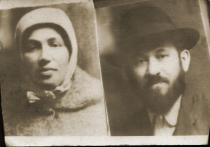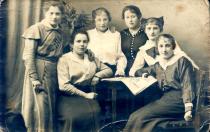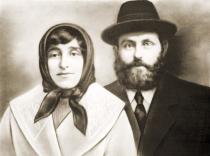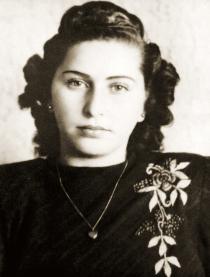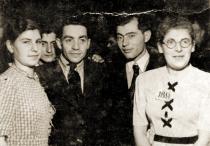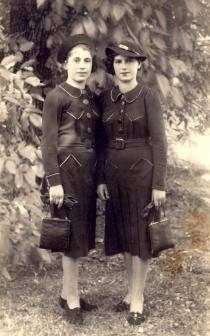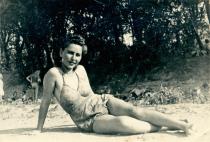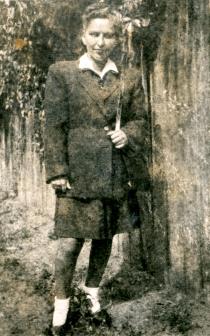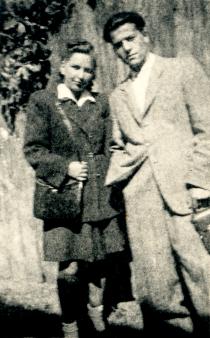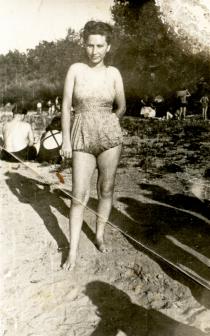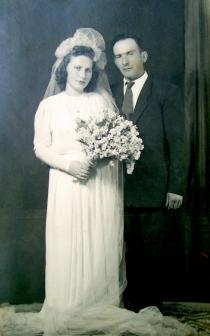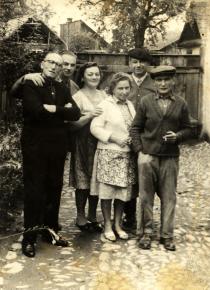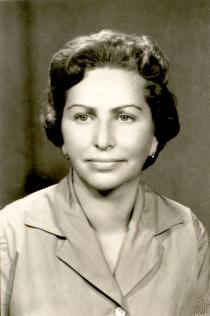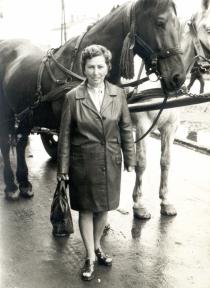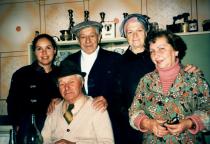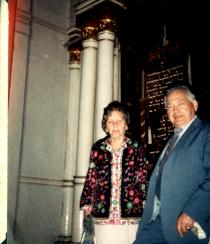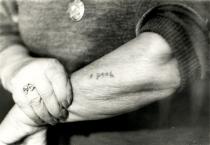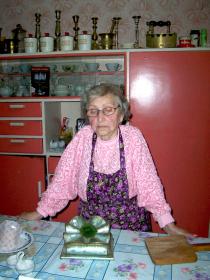It’s me, Golda Salamon on this photo, to the left, and next to me is Belus [Bela] Katz, he is from Maramarossziget, but he emigrated to America.
We met, and he said: ‘Come, let’s take a photo to remember our encounter.’
This photo was taken in the synagogue in Maramarossziget. I still have this blouse and this skirt.
I got this blouse from Israel, it is very beautiful. And this creamy skirt goes well with it, since the blouse is basically black, and the skirt has to be plain, without flowers.
Once I lead great stress on dressing. Once I went every week to the hairdresser.
My hair was so beautiful, that one could take delight just in seeing it.
I had plait when I was a girl, but after that I had short hair, and it was arranged in curls. Back then the fashion was to wear curls.
The Sephardi synagogue is the one that is still left, they didn't demolish it.
Before the war, when we had our great festivals, Rosh Hashanah for example, meaning New Year, they always engaged a famous cantor from Bucharest, Varad [short for Nagyvarad], Kolozsvar, who was praying and who conducted the whole liturgy, thus the prayer sounded great.
These cantors are usually opera singers, so they must have a good voice.
On these occasions religious Jews came to that synagogue too to listen to the cantor.
Still there were many Jews in those times, the seats in the synagogue were numbered, and one could buy a place.
During autumn festivals you had to give cash for a seat, you couldn't get in just like that, up there were seats for women, and down for men.
Hasidim too engaged many times cantors in the great synagogue. If not, there was a chazzan who could pray well, and had a good voice.
But there wasn't any opera singer, any cantor. Festivals were very beautiful once.
On the Day of Atonement the 'Kannedra' [Kol Nidre] started in the evening was so beautiful, it was very nice once.
After I got married in 1946, I attended the synagogue. During the autumn festivals I had a seat bought in the second line, Danczig was praying, he was the rabbi.
He was wearing a helmet similar to the priests' helmet, and a large claret belt [on his waist], knitted like the catholic priests' belt, our rabbi was dressed similarly.
All this was after the war, he came back to [Maramaros]Sziget, and emigrated to Israel from here.
Since we are just a very few left, it [the praying] is organized in the small synagogue, there is a chazzan, Sandor Leihter, and a part is fenced off, where women sit.
But nowadays I don't go to the synagogue, because there aren't Jews. With whom should I go to the synagogue? Should I sit there by myself?
There are mixed marriages, one has a 'ruszka' [Russian] wife, the other I don't know what, these come. No, I prefer to pray at home.
After my first husband died, a neighbor woman and me went to the central [ritual] bath, in a room with two bathtubs, and we took a bath there.
We went there once in a week or once in two weeks. In 1980 it was still functioning, but then it was closed. After Jews left it was closed, and people started to modernize, everybody set up a bathroom in their house. They didn't go to such ritual baths anymore.
The other day a bus came with young people - there were Jewish children among them, but most of them were Romanians -, who got out from the bus at the synagogue, and they looked for me, I had to explain them, to these young people, the things I had gone through, so that it won't occur again what it had happened in 1944.
That they slaughtered like this people. Since I was for one year and four months in lager, when they deported me from here.
But a very few returned, very few. Those young people asked me questions, and I had to answer all of them.
In Romanian, as there were Jewish children among them, but just a few, the greater part was Romanian, who won't believe even today, that there had been such a slaughter.

